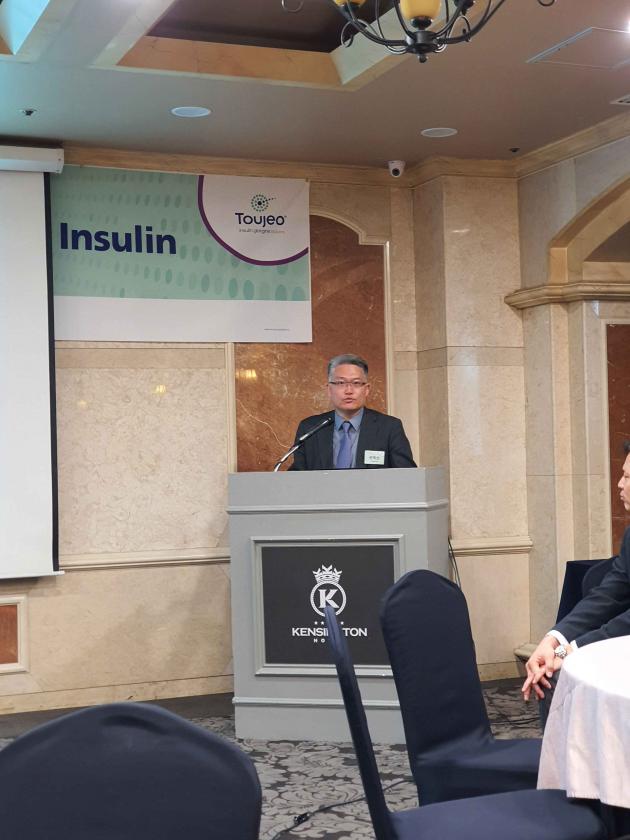Local diabetes experts on Wednesday stressed the need to treat diabetes at an early stage to reduce the high diabetes hospitalization rate in Korea.
According to a recent report released by the OECD, the number of hospitalized patients with diabetes in Korea was 245 per 100,000 people, the second-largest among member countries after Mexico. The report also showed that Korea ranked sixth among 36 OECD nations in the overall mortality rate from diabetes.

"In Korea, when patients are diagnosed with diabetes, their insulin secretion abilities are already reduced to less than 50 percent and drops to as much as 25 percent after six years," said Professor Kwon Hyuk-sang at the Catholic University of Korea Yeouido St. Mary's Hospital, during a Sanofi-Aventis news conference. "Such a decrease in abilities has highlighted the need for early insulin therapy to protect beta-cell functions, which secretes the insulins."
If the glycosylated hemoglobin does not reach the target even if doctors use oral hypoglycemic agents at a maximum dose or when they combine two or more types of drugs, it means they have to use insulin before the glucose level worsens, Kwon added.
The Korean Diabetes Association recommends patients with type 2 diabetes to maintain the glycated hemoglobin (HbA1c) level of less than 6.5 percent.
"However, it takes about 10 years for patients to receive insulin treatment after diabetic diagnosis, and most patients start taking the insulin at an HbA1c of 9.2 percent," Kwon said. "What is more alarming is that even though local patients are late at the beginning of insulin treatment, their insulin use rate continues to be low even after beginning treatment."
According to Kwon, the local prescription rate for insulin has been steadily falling since 2009 and is reported to remain at 9.1 percent in 2016.
"There are anxieties and avoidance of injections of insulin globally, but Korean patients seem particularly unwilling to take their insulin," Kwon said. "Especially with the introduction of new treatments such as sodium-glucose co-transporter 2 (SGLT-2) inhibitors, it seems like the insulin repellent problem is getting worse."
However, as the risk of death can increase with diabetes and chronic kidney disease, it is essential to prevent complications through active blood sugar management, Kwon emphasized.
The professor pointed out that diabetes should be addressed early with medication and lifestyle therapy. If patients need to use insulin, however, doctors should prescribe insulin as soon as possible to see a good prognosis.
"Oral drugs are getting better every day, but as insulin is the most obvious way to control diabetes, we need to consider its importance," Kwon said.
In another news conference organized by Novartis, Professor Park Chul-young Kangbuk Samsung Hospital also advised patients to treat diabetes early.

"It's natural to see a higher incidence of diabetes as the population gets older, but both doctors and patients are neglecting that it is important to preserve the function of beta cells that produce insulin as much as possible," Park said. "Until now, we've mostly focused on preserving the functioning of the pancreas."
However, it is crucial to preserve the function of beta-cell, and treatment is recommended as soon as possible to prevent and slow down the decrease of beta-cell function, Park added.
According to Professor Park, the need for early combination therapy in diabetes has been recognized among experts for some time, but the consensus has not reached the patients. "This is because it was not easy to convince patients to take insulin at an early stage of diabetes," Park said. "In general, seven out of 10 early diabetics don't want to take medicine and want to exercise and control their diet instead."
Professor Park expects that this may well change, as Novartis' VERIFY study has recently proved the strong need for early treatment for diabetes.
The VERIFY study evaluated the five-year persistence of early Galvus and metformin combinations in patients with early diabetes, who had an HbA1C of less than 7 percent. The mean disease duration was 3.3 months, and HbA1C was 6.7 percent.
As a result, the early combination therapy for Galvus and metformin reduced the relative risk of initial failure by 49 percent when compared to metformin monotherapy.
Even patients who began treatment with metformin monotherapy had a 26 percent reduction in secondary treatment failure rates as soon as they switched to Galvus and metformin combination therapy.
"The VERIFY study included patients with a variety of socioeconomic characteristics that can represent real patients," Professor Park said. "Of course, it is difficult to guarantee that the guidelines will change as a result, but it will have a lot of impact on patients."

